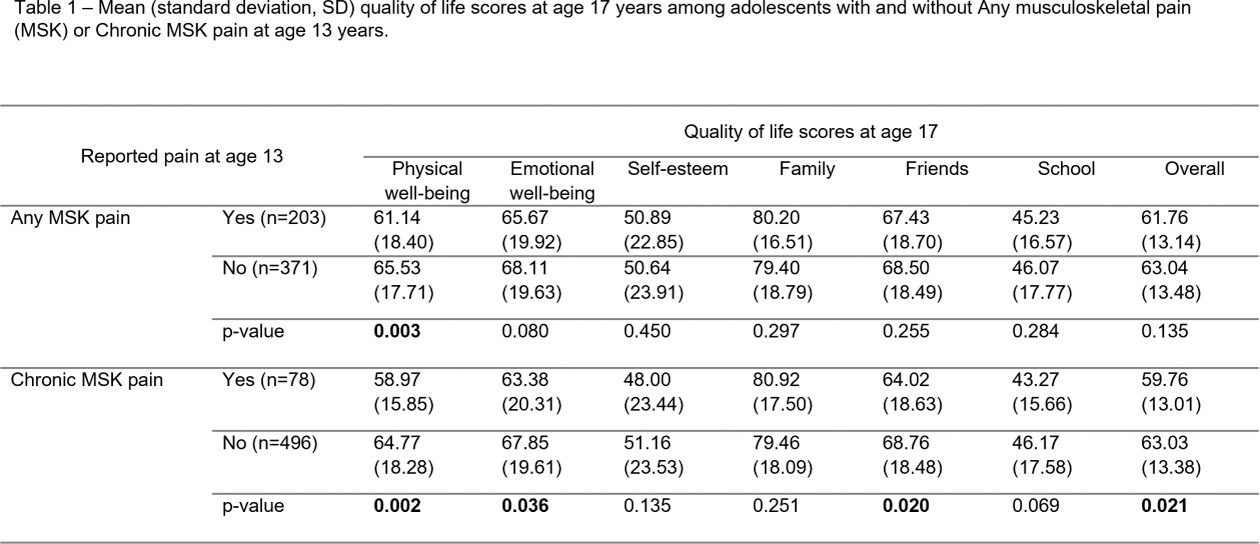

Background: There are well-documented associations between musculoskeletal pain reports and concurrent quality of life from early ages. Much less is known on whether adverse pain profiles in pediatric ages, including pain reports and somatosensory responses to painful stimuli, may also have a long-term effect on quality of life, particularly in non-clinical settings.
Objectives: We aimed to quantify the association between musculoskeletal pain at age 13 years (reported history and experimental pressure pain responses) and quality of life four years later in a large population-based birth cohort.
Methods: We used data from Generation XXI, a population-based birth cohort established in 2005/6, in Porto, Portugal. After recruitment at birth, the whole cohort was invited to attend follow-up evaluation waves, including at ages 13 and 17 years. At age 13, the Luebeck pain questionnaire was used to collect data on pain history (n=574). We used as exposures Any musculoskeletal pain (any pain in the previous 3 months in lower/mid back, neck/shoulders, upper and lower limbs, hips, unspecified musculoskeletal, or generalized pain) and Chronic musculoskeletal pain, when it lasted over 3 months. Additionally, a subsample (n=192) underwent quantitative sensory testing using computerized cuff pressure algometry. To assess pressure pain sensitivity, pain detection (PDT) and tolerance thresholds (PTT) were collected. Participants also underwent 10 sequential PTT pressure stimuli, which they rated using a visual analogue scale (VAS) for intensity. Average scores for stimuli 1-4 (VAS-I) and 8-10 (VAS-II) were computed and temporal summation of pain effect was defined as VAS-II minus VAS-I. At age 17, due to COVID-19-related restrictions, a remote evaluation was conducted where participants answered questionnaires via a dedicated mobile app (ispup.up.pt/sepia). Quality of life was assessed in six subscales (physical well-being, emotional well-being, self-esteem, family, friends and school) using the validated Kiddo-KINDL questionnaire. The overall quality of life was quantified as the sum of subscale scores. Comparative analysis was conducted using t-tests. Associations between experimental pain responses and quality of life were quantified using linear regression.
Results: Adolescents reporting Any musculoskeletal pain at age 13 (35.4% of the sample) had, at age 17, significantly lower mean scores in the physical well-being subscale compared to those who did not have any musculoskeletal pain (61.14 vs. 65.53, p=0.003). Differences were more pronounced among adolescents who had Chronic musculoskeletal pain at 13 (13.6% of the sample), who, four years later, reported lower quality of life scores for the physical well-being (58.97 vs. 64.77, p=0.002), emotional well-being (63.38 vs. 67.85, p=0.036) and friends subscales (64.02 vs. 68.8, p=0.020) and overall quality of life (59.76 vs. 63.03, p=0.021) when compared to those who had not report Chronic musculoskeletal pain at age 13 (Table 1). Around 85% of the participants with pain did not have an associated diagnosis of chronic disease.
As for experimental pain responses (Table 2), there were no clear associations between pressure pain detection or tolerance thresholds at 13 and quality of life at 17 but temporal summation of pain (VAS-II minus VAS-I) was associated with physical well-being [-2.24 (-4.31 to -0.18)], emotional well-being [-3.77 (-6.05 to -1.48)], friends [-3.03 (-5.22 to -0.84)] and overall quality of life [-2.23 (-3.86 to -0.60)].
Conclusion: Chronic musculoskeletal pain and enhanced temporal pain summation in early adolescence were associated with lower quality of life four years later. Our findings underline the long-term implications of pediatric pain and the importance of early assessment and management in shaping future psychosocial well-being.
REFERENCES: NIL.


Acknowledgements: This work was supported by a research grant from FOREUM Foundation for Research in Rheumatology (Career Research Grant). The cohort study is supported by FCT - Fundação para a Ciência e Tecnologia, I.P. through the projects with references UIDB/04750/2020 and LA/P/0064/2020 and DOI identifiers
Disclosure of Interests: None declared.